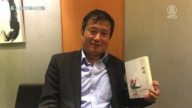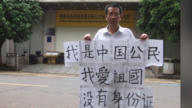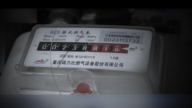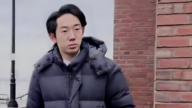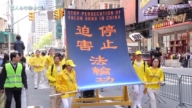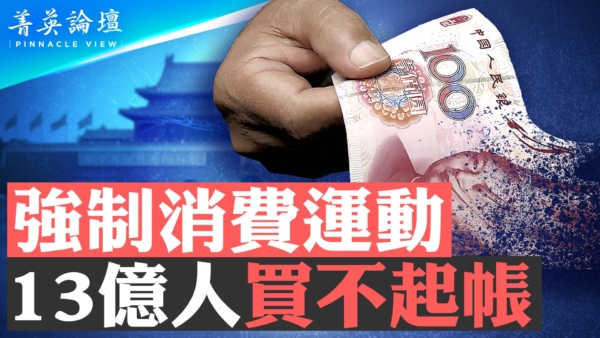【新唐人2011年6月29日讯】中共为建党90周年党庆,在全国范围内掀起了红色风潮,包括唱红歌、跳红舞、播红剧、背毛诗、贴大红标语、做巨幅党旗、万名党员宣誓等等。国内民众和海内外学者指出,又回到了文革疯狂的时代,党庆红潮在全国耗资数万亿,老百姓怨声载道。
6月27号,《新华网》头条,报导了重庆市风景区展示了一面600平方米的巨幅党旗。这还不是最大的,重庆市星光学校竟制作了一面长90米、宽40米、达3600平方米的党旗。北京、上海、河北、湖南、山西等地,都竞相制作巨幅党旗。
安徽合肥市包河风景区用4000多米长的红绸缎,包裹街道两旁的梧桐树,将2公里长的芜湖路打造成合肥首条“红色主题街”。
发源于重庆的“唱红运动”已推广到全国各地,从机关到街道,从工厂到学校,甚至把红歌唱到监狱、精神病院和寺庙。江苏淮安市6月20号举办宗教界红歌大赛;四川西昌市统战部19号组织五大宗教团体唱红歌汇演。
而重庆市委书记薄熙来6月11号带领千人红歌团,到北京民族宫大剧院演出。重庆市政法委书记刘光磊表示,要将囚犯唱红歌的好坏,作为减刑和假释的依据。
北京市民:“有一笑话,唱红歌都唱到监狱里:‘我们是共产主义接班人’,把共产主义接班人都关监狱去了。现在北京大搞文革式‘万人合唱’,各个单位现在都搞这个。那街坊老人讲:这能唱出麦子来吗?这能唱出粮食来吗?能唱出猪肉来吗?能把物价唱落了吗?”
中国政法大学法学院副院长何兵教授指出:重庆累计唱红10.4万次场,参与人数8000万,场地费服装道具一人1500元,共计2.1亿元,每人次误工费、交通费加起来共计2700亿。如果全国唱红会是几万亿,为什么不搞医保?!
而中央电视台却说,唱红歌完全是群众自发的。西安市民反驳说:“各个单位、各个街道唱红歌、跳红舞,早晨起来打小鼓。完全是政府补贴和操纵的,任务下达的。”
国内网民对此议论纷纷,人民网《强国论坛》的网友说:“红歌就是人民鲜血染红的歌;拿百姓的血来歌功颂德?无耻。”还有“红歌唱了几十年,越唱人民越可怜;贫富分化差别大,看病就业买房难!”
上海市民:“上海现在每个街道红歌比赛,退休的老年人、有些是没工作的,来了给你们30块钱,然后吃顿饭、给钱,这个钱它愿意付的。单位也是一样的,都是增加点奖金。搞这种宣传有什么用呢?没用的!它末日到了,很快的。老百姓心中怨气很多,人家敢怒不敢言,它已经失去民心了。”
除了“唱红运动”,重庆市委教育工委19号举行“大学生党员宣誓活动暨高校党旗领航行动计划”启动仪式,万名大学生党员现场宣誓。
北京大学法学院贺卫方教授指出,这种“集体和强制性的狂欢”,被当局作为“驯服和动员民众的精神力量”。而这些红歌里,隐含或张扬着“个人崇拜”,“嗜血的仇恨”,集体主义同时压制个人尊严和自由主义。
上海“共产党红学”研究者任海勇表示,经过几十年经济改革之后,人们普遍丧失对共产主义的信仰,中共政府因而明显表现出恐惧,因为这意味着中共政治制度的依托已经不复存在,当局“病急乱投医”。
而时事评论家横河说:“一种就是毛泽东时代的复辟的倾向,这个是以重庆的唱红为主的,从中央到各地都有程度不同的附和和跟风。地方诸侯到中央去,试图引领中共的意识型态的方向,这在中共建政以来还是第一次,这是向左的方面转。”
《法国国际广播电台》说,这些红色歌曲就像浸透着专制毒汁的“恶之花”。中共已经意识到,他们失去了民心民意。国内网民则指出,“红潮”继“文革”之后,再次席卷中国大地,尽显中共末日景象。
新唐人记者李元翰、萧宇综合报导。
CCP Sets Off Red Waves for Its Anniversary
The Chinese Communist Party (CCP) has recently
launched a nationwide “Red Wave Movement"
to celebrate its 90th anniversary, including red songs,
dances, and plays, as well as huge red Party flags and
banners, Mao’s poems, and nationwide CCP pledges.
Many people believe that the CCP “has brought back
the Cultural Revolution."
These “red wave" antics have cost the nation thousands
of billions of yuan, drawing intense public ire.
On June 27, Xinhua Net’s headlined a story about a
huge Party flag of 717 square yards in a scenic spot in
Chongqing City. Yet, this wasn’t the biggest flag.
A Party flag made by Xingguang School in Chongqing
measured a whooping 4,305 square yards!
Huge party flags are also showing up in Beijing,
Shanghai, Heibei, Hunan, and Shanxi.
A scenic spot in Baohe District, Hefei City, Anhui
Province used 4,374 yards of red silk to wrap trees
alongside Wuhu Road, making the 2,187 yard long
road the first “red theme road" in Hefei City.
The Red Song Movement, which originated in
Chongqing, has spread nationwide, from official
institutes to local communities, from factories to
schools, including jails, mental hospitals, and temples.
Huai an City, Jiangsu Province held a red song
competition in a religious community on June 20;
Xichang City United Front Department, Sichuan
Province, organized a red song performance involving
five religions on June 19.
Bo Xilai, Chongqing’s Party Secretary, led a red song
troupe of thousands of people to Beijing’s Grand
Theater of Nationality Palace on June 11.
It was claimed that Liu Guanglei, secretary of the
Chongqing Politics and Law Committee, would reduce
prisoners’ sentences according to how well they sang
the red songs.
A Beijing citizen said: “There is a joke about the ‘Red
Song Movement’ in jails: ‘We are the Communist
successors, who jails Communist successors’.
Beijing is organizing Cultural-Revolution-style
‘mass choruses’ in every official institute.
Many senior citizens ask, ‘Can the red songs buy wheat,
food, or pork? Can they bring food prices down?'"
Professor He Bing of the Chinese University of Politics
and Law, said: “Chongqing has held 104,000 red song
performances with 80 million participants. Costumes
cost $31 million or $231.838 per person, not including
the time lost from work and transportation costs, which
would add up to $41.7 billion. Thus, these “red waves"
could cost the nation hundreds of billions of dollars
Why not use the money for medical insurance?!"
China Central Television (CCTV) said that, those red
song performances were organized by people
themselves. A Xi an citizen refuted the CCTV claim.
“Each institute or local community which organizes
red songs, dances, and tabors every morning was
required, organized, and supported by the government."
Many Chinese citizens criticized the CCTV’s words.
A netizen said on People Net’s Strengthen the Country
Forum: “Red songs are stained by people’s blood.
Why use people’s blood to praise the CCP? Shameless!"
and “Red songs have been sung for decades while people
are getting poorer; the rich-poor polarization is huge,
and it’s getting harder to see doctors or buy houses!"
A Shanghai resident said, “Every Shanghai community
is holding red song competitions among the retired or
unemployed. Each person receives about $5.00 and
a meal, which is paid for by the government. It’s the
same case in the different institutes, where participants
are paid. But what is the propaganda for? It’s useless!
The end of the CCP is definitely drawing near.
People are very discontent, but dare not express it.
The CCP has truly lost the hearts of the people."
Besides the Red Song Movement, Chongqing’s
Education Department held a college student leadership
opening ceremony, so that students could pledge their
allegiance to the CCP and wave Party flags."
Tens of thousands of college students made
Party pledges on the spot.
A law professor from Peking University, He Weifang,
said that this kind of “forced group revelry" is a kind of
“spiritual power" that the CCP uses to “control and
mobilize the people."
These red songs directly or indirectly advocate
“self-glorification," “bloody hatred," and collectivism,
which supersedes human dignity and freedom.
Ren Haiyong, a Shanghai expert who studies
“Communist Redology," said that after decades of
economic revolution, people have already lost their
belief in Communism, making the authorities fearful.
Thus, the political basis of Communist rule is lost.
Feeling desperate, the CCP is willing to try anything."
Heng He, a current affairs commentator, said,
“One way the CCP is trying to revive Communism is to
bring back the Mao Zedong era, represented by
Chongqing’s Red Song Movement, followed by local
and central authorities Red Song Movements.
This is the first time in the CCP’s history that local
authorities have lead central authorities’ ideology.
This is a sure sign of “left-leaning."
Radio France Internetionale (RFI) said that, these
red songs are “flowers of evil" drenched with
despotic venom.
The CCP has realized that it has lost the people’s hearts.
Chinese netizens say that, “red waves” swept over
China after the “Cultural Revolution,” which
foretells the end of the CCP’s reign.
NTD reporters Li Yuanhan and Xiao Yu.


